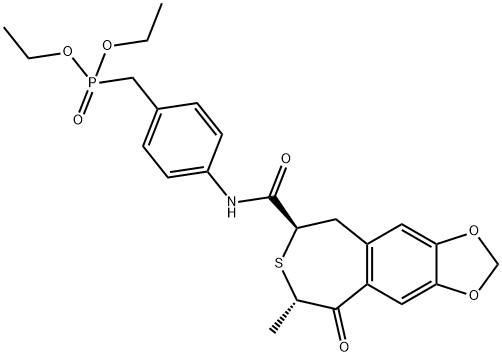180185-61-9

基本信息
Phosphonic acid, P-[[4-[[[(6R,8S)-5,6,8,9-tetrahydro-8-methyl-9-oxothiepino[4,5-f]-1,3-benzodioxol-6-yl]carbonyl]amino]phenyl]methyl]-, diethyl ester
物理化学性质
| 熔点 | 181-182 °C |
| 沸点 | 742.3±60.0 °C(Predicted) |
| 密度 | 1.334±0.06 g/cm3(Predicted) |
| 储存条件 | -20°C储存 |
| 溶解度 | 溶于二甲基亚砜 |
| 酸度系数(pKa) | 13.12±0.70(Predicted) |
安全数据
| 危险性符号(GHS) |  GHS07 |
| 警示词 | 警告 |
| 危险性描述 | H302 |
| 防范说明 | P280-P305+P351+P338 |
常见问题列表
TAK-778 is a derivative of ipriflavone and has been shown to induce bone growth in in vitro and in vivo models. Continuous treatment with TAK-778 (10 μM) for 1 to 21 days results in an increase in the area of mineralized nodules. TAK-778 at concentrations of 1 μM and higher significantly stimulates the activity of cellular Alkaline phosphatase (ALP). TAK-778 increases slightly but significantly the DNA content of the cells at the confluence stage. Treatment with TAK-778 also results in dose-dependent increases in the amount of soluble collagen and osteocalcin secreted into culture medium from days 5 to 7. TAK-778 enhances the secretion of both TGF-β and IGF-I at every time point during the 21 days of culture. Treatment of the cells with TAK-778 does not induce ALP activity, but does result in a dose-dependent increase in the saturated cell density. TAK-778 at a concentration of 10 μM significantly reduces the saturated cell density.
Treatment with a single local application of TAK-778/PLGA-MC (0.2 to 5 mg/site) results in a dose-dependent increase in the radio-opaque area formed in the defect. Histological studies show the defect area is occupied by a bony bridge and the newly-formed radio-opaque area corresponds to a calcified bone containing bone marrow cavities surrounded by thick osteoid seams with cuboidal osteoblasts. There is no significant difference in either of the indices between placebo- or TAK-778/PLGA-MC-treated skulls. Two months after the operation, the TAK-778/PLGA-MC pellets induce radiological osseous union across the defects. Oral treatment of OVX rats with TAK-778 causes a more pronounced increase in bone mineral density (BMD) of the lumbar vertebrae compare to vehicle controls.